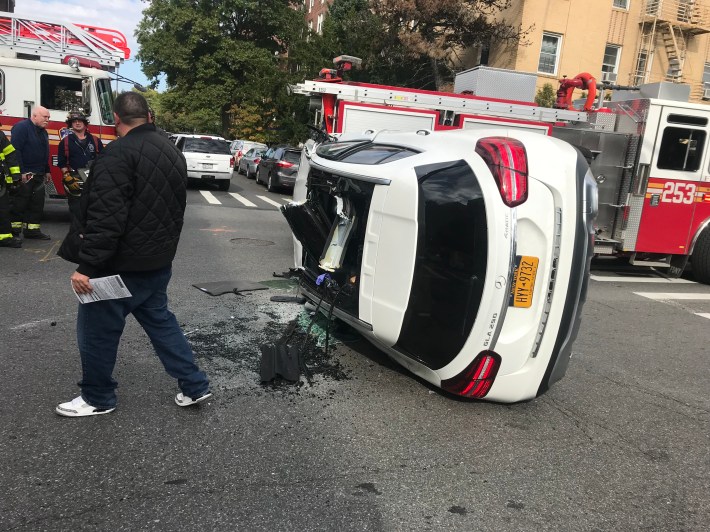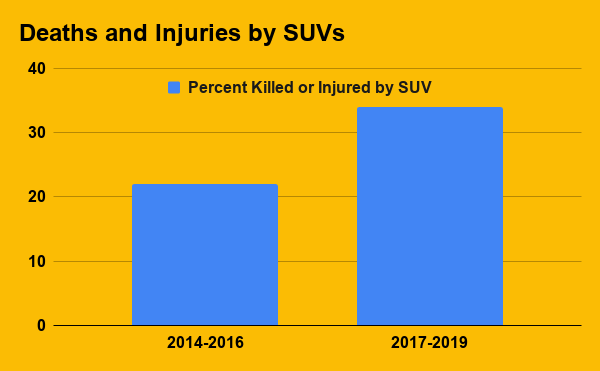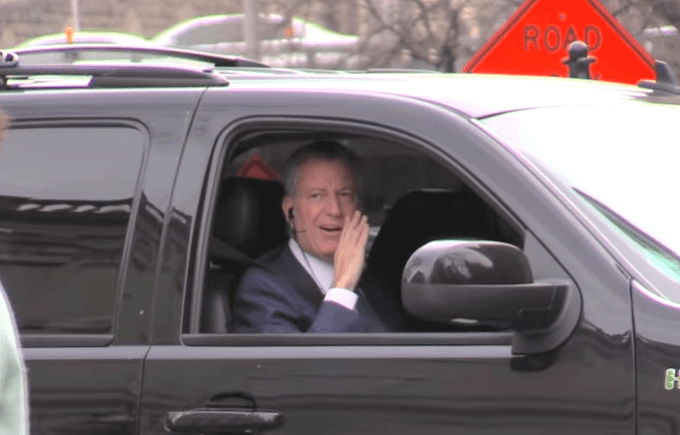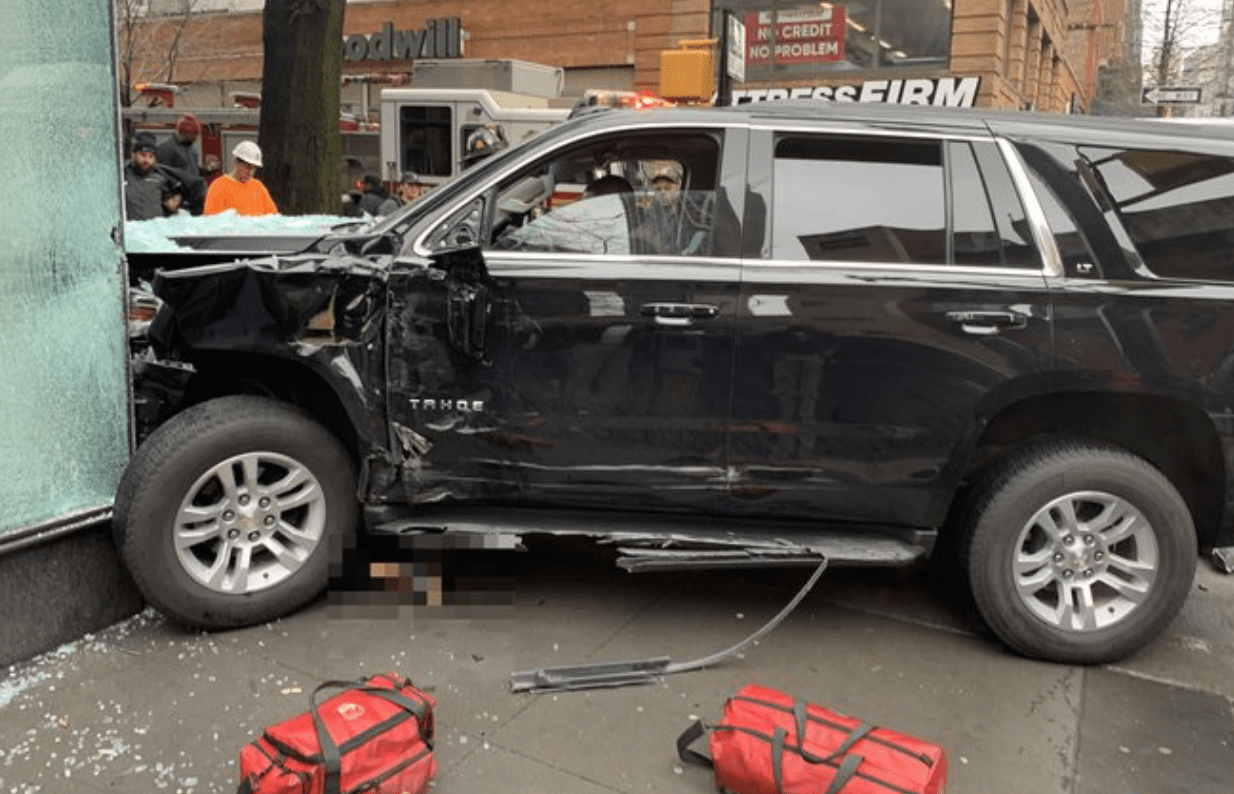The de Blasio administration will need to adopt policies limiting the size and scope of SUVs and light trucks on city streets if it wants to start driving down crash fatalities and injuries.
Otherwise, Vision Zero basically will have failed.
That’s the takeaway from a Streetsblog analysis of crash statistics comparing the first three years of Mayor de Blasio’s six-year tenure with the second — and an urgent policy question as New York ponders a simultaneous car and bike boom in its post-pandemic future.
“The large-vehicle trend is a perfect storm for cities,” said Gregory Shill, a University of Iowa law professor who studies how American institutions privilege driving.
The federal government — which regulates vehicle safety — prioritizes the safety of car passengers and not that of other drivers or people outside of vehicles. So, Shill concludes, “If cities want to protect their people from this storm, they’re going to have to take action on their own."
“Legally, the simplest way to do it is to create more car-free places that don’t distinguish between types of vehicles," he added. "Regulators and automakers are really leaving cities no choice if they want to protect their citizens.”
In other words, we need many more open streets, but we also need more than that.
The analysis, using data at the website crashmapper.org, shows a basically flat number of fatalities and a rising number of injuries over the last six years — raising questions about whether the administration’s Vision Zero policies really have made a difference in stanching the blood tide of vehicle violence that has maimed and killed so many New Yorkers.
Crashmapper, a project of the pedestrian advocacy group CHEKPEDS, has launched a new feature that sheds more light on why Vision Zero has made so little progress; the website now can break out the kinds of vehicles involved in crashes and display the information in pie charts. The new feature enables the public “to better align perceptions with reality,” said CHEKPEDS leader Christine Berthet, at least “as much as the NYPD data will permit.”

The data show that larger, overpowered vehicles — SUVs and trucks — account for a growing share of injury- and fatality-producing crashes, killing and injuring a greater percentage not only of vulnerable road users such as pedestrians and cyclists but also other motorists.
Comparing Jan. 1, 2017 to Dec. 31, 2019 against the previous three-year period, the number of fatal crashes barely budged — dropping to 736 from 761, or 3 percent. The number of injury-producing crashes, meanwhile, actually rose almost 12 percent, to 187,916 from 168,074, according to Crashmapper.
Of the six statistics (fatalities and injuries for pedestrians, cyclists, and motorists) that Streetsblog examined for the two periods, only one showed improvement: Fewer pedestrians died in the second three-year portion of Mayor de Blasio's tenure — 383 versus 426. More cyclists and even more motorists died. Injuries rose for all road users.
New Yorkers might wonder: If there’s one thing we have learned from Mayor de Blasio and Gov. Cuomo during the coronavirus crisis, it’s that we are not “out of the woods” unless all our bad indicators are dropping in tandem.
The administration, obviously, knows that SUVs are a menace to life and limb.
“The popularity of SUVs and light trucks are contributing to the increase in roadway fatalities in New York City and nationally,” Department of Transportation Commissioner Polly Trottenberg told reporters in December. “If you’re behind the wheel of one of those vehicles … you need to take extra caution. It has a lot more weight…poor visibility, it takes you longer to brake and it is harder to see around turns. Drivers of those vehicles need to drive very carefully to compensate.”

The flat stats don’t mean that the billions of dollars that the city has spent on Vision Zero improvements, such as protected bike lanes, leading pedestrian signaling, more and better crosswalks and the like, have gone for naught. If the city hadn’t invested in those improvements, the toll of vehicle-related deaths and injuries likely would have risen much higher, given the rise in car traffic in the city. Moreover, with the recent spike in cycling and walking because of the coronavirus emergency, the need for safe cycling and pedestrian infrastructure only has grown.
Rather, the stats point to the need to reduce the number and size of SUVs and trucks on city streets, to constrict the routes they can take, and maybe even to restrict the times drivers can operate such vehicles to hours when they are less likely to cause collisions. Otherwise, the city will have spent a lot of money in order to tread water — and may fall backward if, as many predict, more people start driving in order to avoid transit because of coronavirus fears.
City planners understand this — at least regarding larger trucks. Recent reforms to the private garbage-carting industry have set limits on the length of truck routes and have mandated safety features on vehicles. Ideas for setting truck-delivery hours for low-traffic times, such as early mornings, and the creation of more residential loading zones, could further reduce time/space conflicts for the large vehicles.
But SUVs present a more difficult political problem because so many families own them (even if a minority of New York households own cars). As most New Yorkers can see, during the last decade SUVs and pick-up trucks have replaced sedans more and more on city streets. (The New York Times recently celebrated the ascent of the SUV, with a story that did not have a single word about the concomitant ascent of the death toll.)
There were 66.4 million SUVs and 52 million pick-ups on American roads in 2017, up from 40.5 million and 41 million, respectively, in 2008, according to the U.S. DOT. It’s only getting worse. The market share of “light trucks,” including SUVs, pick-ups and vans, willies to 78 percent of sales in 2025 from 72 percent now, a market analyst recently told the New York Times.
As Trottenberg indicated, bulkier, overpowered vehicles are more dangerous — even, apparently, for their drivers and passengers, as statistics show — and have greatly increased their share of road carnage. The share of cars involved in crashes has dropped correspondingly as the shares of SUVs and trucks has risen.
Streetsblog used the two three-year date ranges because they encompass the whole of the mayor’s tenure while stopping just shy of the anomalous traffic conditions produced by the coronavirus emergency. Three-year increments smooth out numerical fluctuations and show trends more faithfully over time.
Still, what the stats show is startling.

From 2014 to 2017, 426 pedestrians died in crashes — and of those, 107 (or 25 percent) were killed by SUV drivers, and 52 (12 percent) died in crashes involving trucks. From 2017 to 2020, there were fewer overall pedestrian deaths: 383. But SUV drivers killed a greater share: 146 (or 38 percent). Truck drivers also killed a greater share: 61 people, or 16 percent.
SUV drivers also increased their share of pedestrian injuries: From Jan. 1, 2014 through Dec. 31, 2017, 33,673 pedestrians were injured on the streets of New York City. SUV drivers injured 7,630 of them (or 25 percent) and truck drivers injured 1,608 (or 5 percent). From Jan. 1, 2017 through Dec. 31, 2020, there were roughly the same number of injuries, but injuries caused by SUV drivers jumped to 11,538 (or 34 percent). Injuries caused by truck drivers fell slightly to 1,416 (or 4 percent).
The same pattern repeats for cyclist deaths/injuries — but on steroids. From Jan. 1, 2014 to Dec. 31, 2016, 10 of the 57 cyclists killed (or 17 percent) died in crashes involving SUVs and 8 (or 14 percent) in crashes with trucks. In the first period, 2,485 of 13,426 cyclist injuries (or 19 percent) came from SUV crashes, and 532 (or 4 percent) from truck crashes. But in the second period, Jan. 1, 2017-Dec. 21, 2019, 66 cyclists were killed, 19 (or 28 percent) of those died in SUV collisions and 20 (or 30 percent) were killed by truck drivers.
The carnage has fully engaged the attention of cycling activists, and prompted the administration to promote a “Green Wave” of pro-bike traffic reforms, many of which, sadly, are falling victim to pandemic-related budgetary constraints.
But most surprising was the share of motorists who died or were injured in crashes involving SUVs and trucks — a counterintuitive finding when we consider that many motorists purchase SUVs or pick-ups believing that they are safer.
Of the 278 motorists killed during the first period, 51 (or 18 percent) died in crashes involving SUVs and 15 (or 5 percent) in crashes involving trucks. Of the 287 who died in 2017 to 2020, 85 (or 29 percent) were killed in crashes involving SUVs and 22 (or 8 percent) in those involving trucks.
Of the 120,975 motorists injured from Jan. 1, 2014 through Dec. 31, 2017, 25,973 (or 21 percent) were hurt in crashes involving SUVs and 5,794 (or 5 percent) in crashes involving trucks. From Jan. 1, 2017 through December 1, 2020, 50,634 (or 36 percent) of 139,756 motorist injured were hurt in crashes involving SUVs and 7,058 (or 5 percent) in crashes involving trucks.
NYPD data does not always indicate whether those motorists died or were injured in crashes involving a single vehicle or collisions of car on SUV, SUV on truck, etc., nor does it sort whether a fatality was the driver or a passenger. Nevertheless, the trend is concerning.
So what does the city plan to do about the carnage?
The DOT “recognizes that a few key behaviors that contribute to roadway fatalities are due to reckless driving, which may include speeding, failure to yield, and distracted driving,” a spokeswoman said. The department pointed to a number of education, engineering and enforcement efforts — none of which specifically addresses SUVs and light trucks:
- the speed-camera program
- left-turn-calming treatments instituted at various intersections, which help raise visibility, including for larger vehicles,
- an annual Dusk and Darkness safety campaign in which NYPD and DOT street teams are stationed in Vision Zero priority areas to promote safe motorist behavior,
- the “Alive at 25” program, which works with high-school students on safe driving,
- and efforts to promote pedestrian and cyclist awareness in driver education.
The DOT might have added the rhetorical measures it has undertaken, such as last year’s $4-million “Was It Worth It?” ad campaign, which deployed 23 billboards and ads in print, on TV and on the backs of buses to exhort drivers to be more careful. It also announced that it would track fatal crash data more granularly in order to better inform policy.
It’s not enough. Besides expanding and making permanent open streets, activists say the city should:
- enact weight limits on streets for passenger vehicles, as some municipalities in California have done,
- discourage SUVs and light trucks from entering the Central Business District through differential congestion tolling,
- find ways to tax passenger vehicles far more by weight, size and horsepower,
- outlaw so-called crash or bull bars, a pedestrian-slaughtering device that is illegal in Europe and endangers vehicle occupants, too,
- rid SUVs from the bloated city fleet,
- and forbid city agencies, especially the NYPD, from buying more of them. As we saw this past week, some members of our militarized police force, in a bind in the George Floyd demonstrations in Brooklyn, resorted to an off-label use of SUVs as a kind of battering ram against protesters. Would they have tried it in their old Crown Victorias? It must not stand.

Finally, the mayor could lead by example and abandon his own taxpayer-funded monster ride, as reporters have demanded for years. Many have noted de Blasio’s Trump-like relations with the press, but his insistence on navigating city streets in a suburban-sized vehicle during the public-health crisis of car carnage will haunt his legacy just as surely as President Trump’s pugnacious refusal to wear a mask publicly during the coronavirus pandemic will haunt his.
The mayor, clearly, must show some political courage and protect vulnerable road users. As it stands, New York is a "Tale of Two Cities" as far as traffic is concerned: one in which it takes a year to remove a single parking space for public use and another in which any yahoo can endanger the public by driving any monstrous vehicle he wants into the city, and put it wherever he wants — for free! Oh, the privileges of property.
Throughout the pandemic, the mayor has said that data informs policy. Yet de Blasio crows that Vision Zero is an unalloyed success — even when the data does not support that.
“I look at what’s happened in the last six years of Vision Zero and I remind everyone, with deepest respect to all my predecessors, this administration decided to do something absolutely radical and put Vision Zero in place,” the mayor told reporters recently. ”And I remember the first months, I remember the naysayers, I remember the people said it would be politically unpopular, it would be impossible, it wouldn’t work, it would be too controversial and I’m very proud to say we forged ahead anyway and in fact built it bigger each year and overwhelmingly Vision Zero has worked.”
Without an effective response to the surge of SUVs and light trucks, the jury is still out on whether Vision Zero has worked or whether, like so much else about the administration, it amounts to a public-relations slogan.






